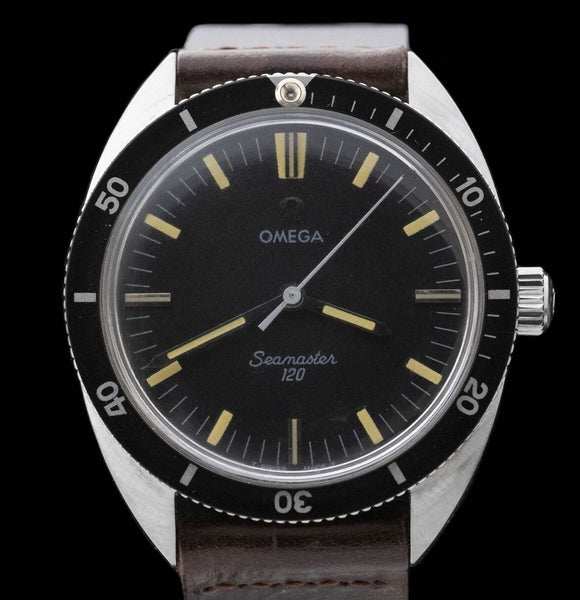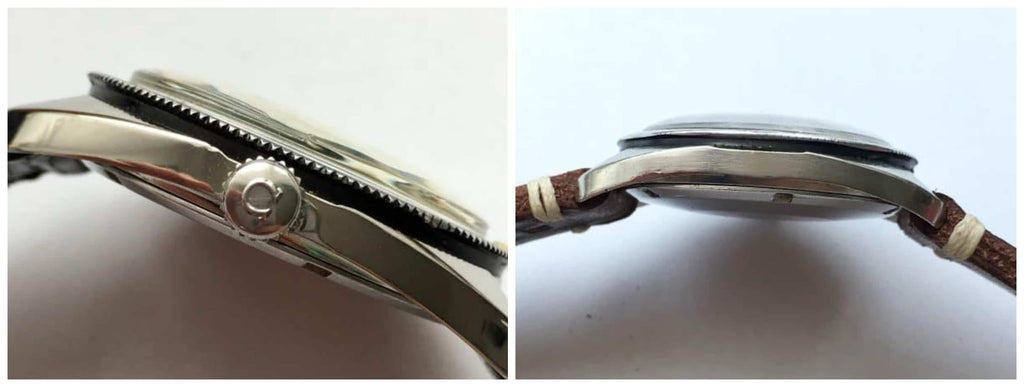What kind of watch is Omega's vintage (antique) Seamaster 120?
In this article, we will explain the Omega Seamaster 120.
If you want to watch the video, please click here ↓
Speaking of Omega divers, there's the 300, but are there 120s too?
I think that's how most people feel, but this is the perfect watch for those who want to enjoy an authentic vintage watch at an affordable price.
At the same time, I will also explain how to distinguish the authenticity of this Seamaster 120, so to some extent, you just need to look at these points of the watch.
I think you can understand what I mean.
By watching this video until the end, I believe you will have a good understanding of the Seamaster 120, so please do so until the end.
The table of contents looks like this.
1. 1966: The birth of the Seamaster 120 and its differences from the 300
2. Four types of Seamaster 120 lineup and one more
3. What to look for to determine authenticity? Explanation of the back cover, case, and dial
Finally, here is a summary.
So let's get started right away.
1966: The birth of the Seamaster 120 and its differences from the 300
In this article, we will introduce the Seamaster 120, the younger brother of the Seamaster 300, released in 1966.
If you don't know much about the Seamaster 300, please read this article:
Omega Seamaster 300 CK2913: A Brief History and Collector's Guide
Following the success of the Seamaster 300, a professional diver's watch released in 1955, Omega designed a smaller model that was waterproof to 120m and released the Seamaster 120, which inherited the DNA of the larger model but was more affordable.
This Seamaster 120 comes with a cushion-shaped 37mm tonneau case as standard, but is also available in a boys' size of 31mm.

※ Omega Seamaster 120 37mm version
What's particularly noteworthy about the Seamaster 120 is that it was Omega's first diver's watch with a date display.
This was well received by consumers, and the date display was then adapted for other models.
One year after the introduction of the date display on the Seamaster 120, the function was also introduced on Omega's premium model, the Seamaster 300.
In contrast to the Seamaster 300, which was only available with an automatic movement, the Seamaster 120 was available in both manual and automatic versions, and both with and without a date display.
Four Seamaster 120 models in the lineup plus one
There are four main references for the Seamaster 120:

To read this table, the models on the left are those without a date display, and the models on the right are those with a date display.
The top row is the hand-wound model, and the bottom row is the automatic model.
In this way, it's great that the same watch is offered in such a detailed range, making it easier to choose the one you like.
Starting from the top left,
1. Reference 135.027: Manual winding, no date, caliber 601, 611 (17 jewels, 19,800 vph, 48-hour power reserve)
2. Reference 136.027: Manual winding, date display, Caliber 613 (17 jewels, 19,800 vph, 48 hour power reserve)
3. Reference 165.027: Automatic, no date, caliber 552 (24 jewels, 19,800 vph, 50-hour power reserve).
4. Reference 166.027: Automatic, date display, Caliber 565 (24 jewels, 19,800 vph, 50 hour power reserve)
By the way, the boys' size is Ref. 535.007 , manual winding, no date, caliber 630. 
The case backs of all four models feature a lightly etched hippocampus, a result of chemical engraving used in the manufacturing process.
Additionally, all four of these 37mm references share the same case, matte bezel, hands, and 5.5mm crown.
The difference between the automatic 165.027 and 166.027 and the hand-wound 135.027 and 136.027 is the shape of the case back: the hand-wound ones are flat, while the automatic ones are domed (necessary for the amount of winding).

*Omega Seamaster 120 case back
What to look for to determine authenticity? Explanation of the back cover, case, and dial
When buying a Seamaster 120, beware of outright fakes with an Omega movement inside.
These movements are then put (and ultimately removed) into other, cheaper Omega watches, and the cases they are fitted into are very often fake.
As prices for vintage Seamasters like this one rise, we are seeing more and more of these far-fetched watches on the market that resemble the Seamaster 120 but are actually questionable.
That said, replacement parts (jewels, crowns, hands, bezels) and restoration work (refurbished dials, polished cases) are considered perfectly acceptable, provided all details are properly disclosed in the watch description, both buyer and seller are aware of it, and it is reflected in the price of the watch.
But whenever you're spending a significant amount of money on a watch, buying from a reputable dealer is part of making an informed decision.
Mistakes will happen, but how the dealer responds when something goes wrong will say a lot about their integrity.
Reputable retailers will always offer a full refund if the watch has been misdescribed or is of questionable provenance.
If you are buying from a retailer for the first time, it is a good idea to inquire about their refund policy before making a purchase.
A genuine Seamaster 120 reference will have small notches in the case at the "3" and "9" positions.

Now let's look at the back cover.

In the image above, the one on the left is real and the one on the right is fake.
Firstly, the etching on the genuine Seamaster watch is shallow and the grooves are shallow.
But the fakes are well and truly dug in.
At the same time, look at part A.
For example, when it comes to the SEAMASTER part, the real A has the top cut off and is flattened.
You can see that the fake one has no cut at the top and is sharply pointed.
Also, make sure the engraving on the case back is spelled correctly.
This may seem like an obvious thing to do, but simple mistakes like this are surprisingly common.
Now let's look at the next case.

The one on the left is fake and the one on the right is the real thing, but the first thing you'll notice is that the pointer at the 12 o'clock position is different.
The fake one has a much larger pointer, almost as wide as the bezel.
And, although it may be tricky to count, there is a difference in the number of bezel ridges contained within each five minutes.
The fake has 10 notches in a 5-minute period, while the real thing has 12 notches in the same 5-minute period.
Now let's look at the dial.

The one on the left is fake and the one on the right is real, and you can tell the difference by the circled parts.
I will explain step by step.
1. The gap between the Omega logo and the letters is wide
The fake one has a range, the real one has almost no range.
2. The letters for Seamaster 120 are different
The S in the name Seamaster is centered on the real watch, but it is slightly higher on the fake one, and the zeros in the 120 are large and not evenly spaced.
From here on, we will show you how to identify the version with date display.
3. The way the "T SWISS MADE T" is inserted is written on a no-date version
On the fake watch, the spacing between the T SWISS MADE T is much wider, but this is the spacing between the no-date displays.
A genuine no-date display actually has this much spacing between the two.
In a genuine model with a date display, the spacing is narrower, and you can see the difference by looking at the genuine model on the right.
The width of the luminous material at the 4 and 6 o'clock positions is different.
This also appears to have been made based on the no-date version, with the fake having a thin layer of luminous material at the 6 o'clock position, while the real thing has about twice as much.
The real no-date version is actually slimmer.
5. The date window is different
The date window on the fake watch is flat, while on the real watch it is shaped like a mountain.
summary
To sum up, I think that while many people know about the Seamaster 300, the only people who know about the 120 are Seamaster enthusiasts.
If you wanted to buy a Seamaster 300 from the 1950s or 1960s today, it would cost you around 2.5 million yen.
However, with the 120 you can enjoy the atmosphere of the time and still purchase it at a low price.
Since there is a small amount in circulation to begin with, prices tend to be quoted, but the 37mm version seems to be trading at around 400,000 to 600,000 yen, and the boys' size seems to be trading at around 350,000 to 400,000 yen.
For those who want to enjoy a vintage watch at an affordable price rather than a new one, I think the Omega Seamaster 120 is the perfect watch.



